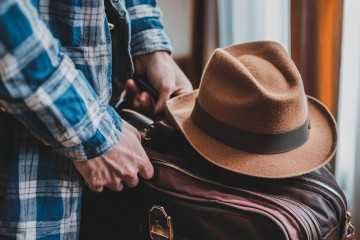Travel stressors, sleep disruptions, and straying from your usual skin-care routine can have negative effects on the skin. The pros share their tips for keeping your complexion healthy and glowing while in transit.
When you’re away from home, it’s easy for your skin-care routine to go out the window. But traveling is one of the times when your skin needs attention the most. “Traveling can wreak havoc on the skin,” says Deanne Mraz Robinson, MD, the president and a cofounder of Modern Dermatology in Westport, Connecticut, and an assistant clinical professor of dermatology at Yale New Haven Hospital.
Not only are you away from the bathroom counter that’s lined with your holy-grail products, but the experience of travel itself can take a toll. “All travel methods, especially planes and trains, involve large commercial vehicles with artificial air circulation systems,” says Scott Flugman, MD, a dermatologist with Northwell Health in Huntington, New York. “This results in prolonged exposure to dry heating and cooling methods, which can result in a significant loss of moisture in the skin.”
Air travel in particular can be dehydrating. One small study found humidity levels on an airplane dropped to 10 percent, which dehydrated the skin of study participants — particularly on their cheeks. (For comparison, the Mayo Clinic says humidity levels between 30 and 50 percent are best.) Dehydration of the air doesn’t lend itself to healthy-looking skin. “It makes fine lines and wrinkles appear more prominently and can leave skin looking dull,” Dr. Robinson says.
There’s also a good chance you’ll encounter some stress along the way, whether you hit an unexpected traffic jam in the car or are in a rush to board your flight. This can trigger an inflammatory response in the body, which can exacerbate conditions such as acne, rosacea, and psoriasis, Robinson says. Extra stress might also cause breakouts, says Marisa Garshick, MD, a New York City–based board-certified dermatologist.
One study found that participants who had stressful jobs and higher daily stress levels were more likely to have acne around the jaw area than less-stressed peers.
Finally, you may not sleep as well when you’re away from home, and that can disrupt the skin’s repair process, Robinson says. Another study reported that even just two days of poor sleep made skin look pale and less attractive.
Luckily, all this can be avoided if you plan ahead. We asked several dermatologists for tips on what they do to keep their skin healthy during travel. Here’s what they recommend.
1. Stay Hydrated Internally to Retain Moisture Externally
The best way to counter the drying humidity levels you’ll experience in flight? Drink water. A study found that increasing water intake by 2 liters a day for one month led to increased skin hydration, which has been linked to younger, healthier-looking skin. Robinson says to start prepping early. “Drink half your body weight in ounces of water for the days leading up to your travel and during your travels,” she says.
2. Keep Your Lips Hydrated With an Ointment
It’s easy to overlook your lips when you’re in the midst of a long travel day, but that’s a mistake, Dr. Garshick says. “Long days of travel can dry out the skin but also the lips, so it’s extra important to keep the lips well hydrated,” she says. She recommends Vaseline or Aquaphor, which are two ointments (aka ultra-moisturizing products), for use en route.
3. Wear Sunscreen Even on Travel Days
If you’re headed to a tropical locale, you’ve likely got your sunscreen and beach hat all packed. It may not occur to you to slather on sunscreen when you’ll be spending most of the day in the airport or on a plane, but it’s a good habit to get into. “Although sunscreen should be applied every day, it is essential on travel days, especially on a plane when you’re even closer to the sun’s ultraviolet rays,” Garshick says. A meta-analysis concluded that pilots and flight attendants have twice the incidence of melanoma, a potentially deadly type of skin cancer, compared with the general population. Protect your skin by putting on sunscreen before takeoff. Garshick likes EltaMD UV Daily Broad-Spectrum SPF 40, which is lightweight and hydrating.
4. Try to Bring Your Usual Products With You
That way, you won’t be asking your skin to adjust to all-new products on top of the other stressors associated with travel. “If you know your skin-care routine works, you should stick with it, even when traveling,” Garshick says. Robinson advises seeking out sample-size versions of your essentials (which include cleanser, moisturizer, sunscreen, and an antioxidant serum). That’s a better option than simply pouring your oils and serums into plastic containers. “Most skin care needs to be stored in a specific way to preserve its effectiveness, so don’t pour it into a travel-size bottle without doing your homework first,” she says. Most vitamin C serums, for instance, are best kept in a cool, dark place away from extreme heat (which is why serums are often sold in dark bottles). Basics, like cleansers, usually do just fine in a travel-size bottle, though, Garshick says.
5. Avoid Using Potentially Irritating Hotel Skin-Care Products
“In this day and age of restrictions on bringing creams and lotions on planes, many people will leave their usual products at home and use whatever is provided to them at a hotel or resort,” Dr. Flugman says. But it’s best to skip those little lotions and soaps stocked in your hotel bathroom. “These products frequently contain fragrances and preservatives that may further compound the usual travel-related dry skin problems,” Flugman says. This is especially crucial if you have sensitive skin, Garshick says.
It’s also a good idea to bring your own small travel-size bottles of nourishing shampoo and conditioner, as hotel brands can dry out the scalp and cause itching, dryness, and irritation. You can also use a hair mask when you arrive at your hotel after traveling to lock in moisture and rejuvenate the hair follicles.
6. Prepare for Acne Breakouts
Even if you follow all the advice above, there’s still a chance your skin will act up while you’re away, so you’ll want to be prepared to treat breakouts. In particular, stress, different water pH and hardness, and the surfaces our head and face touch can cause even the most perfect skin to break out, per research. Tanya Nino, MD, a dermatologist with St. Joseph Hospital in Orange, California, carries a small tube of 10 percent benzoyl peroxide to deal with breakouts.
7. Treat Yourself to a Sheet Mask or Facial Mist While en Route
There’s no shame in giving your skin some love while you’re on the road. “I love to treat my skin to a hydrating mask on a long flight,” Robinson says. Farris, MD, a board-certified dermatologist based in Metairie, Louisiana, advises packing a hydrating facial mist and spraying it periodically throughout your trip to keep skin moisturized. Sure, you may get a few questioning looks from fellow passengers, but the joke’s on them when your skin is hydrated and smooth when the plane touches down.



